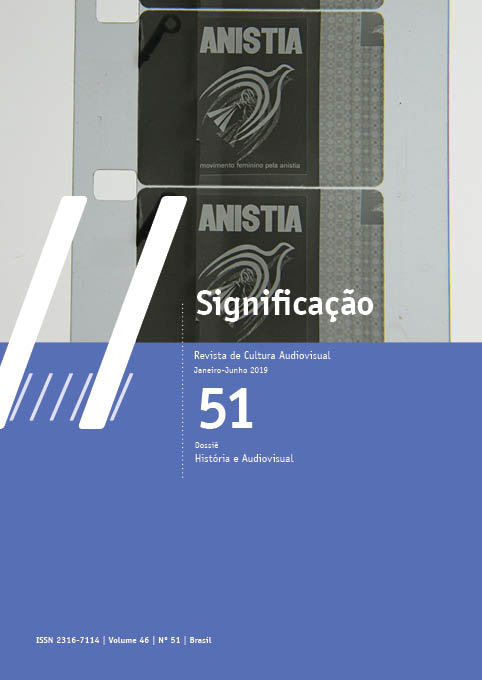The limits of aesthetic experience
colors and narrative cinema
DOI:
https://doi.org/10.11606/issn.2316-7114.sig.2019.150259Keywords:
Experience, Cinema, Colors, Attention, ExcessAbstract
Narratological studies of audiovisual works often focus their analysis on theoretical abstractions. Sometimes the search for hermeneutical explanation, as Hans Gumbrecht interjects, resembles a semantic exaggeration in which the material basis (images and sounds) is reduced to mere vectors of abstract knowledge, the story. Color appears among the neglected themes, an element customarily foreign to academic analysis. This article proposes that color is strategically allocated with the intention of fostering some degree of aesthetic experience on the spectators. The very presence of color for viewers, however, will be
Downloads
References
AUMONT, J.; BERGALA, A.; MARIE, M.; VERNET, M. A estética do filme. Campinas: Papirus, 2009.
BARONI, R.; REVAZ, F. (Ed.). Narrative sequence in contemporary narratology. Columbus, OH: The Ohio State University Press, 2016.
BATCHELOR, D. The luminous and the grey. London: Reaktion, 2014.
BORDWELL, D. Narration in the fiction film. Madison, WI: University of Wisconsin Press, 1985.
______. “Intensified continuity: visual style in contemporary American film”. Film Quarterly, Berkeley, CA, v. 55, n. 3, p. 16-22, 2002.
BORDWELL, D; STAIGER, J.; THOMPSON, K. The classical Hollywood cinema: film style and mode of production to 1960. London: Routledge, 2005.
BORDWELL, D.; THOMPSON, K. Film art: an introduction. 9. ed. New York: McGraw-Hill, 2010.
BOYD, B. On the origin of stories: evolution, cognition and fiction. Cambridge, MA: Belknap Press of Harvard University Press, 2009.
CHATMAN, S. B. Story and discourse: narrative structure in fiction and film. Ithaca, NY: Cornell University Press, 1978.
______. Coming to terms: the rhetoric of narrative in fiction and film. Ithaca, NY: Cornell University Press, 1990.
CURRIE, G. The nature of fiction. Cambridge, UK: Cambridge University Press, 2008.
DAMÁSIO, A. R. O erro de Descartes: emoção, razão e o cérebro humano. São Paulo: Companhia das Letras, 2012.
DONDIS, D. A. Sintaxe da linguagem visual. 2. ed. São Paulo: Martins Fontes, 2003.
ECO, U. Seis passeios pelo bosque da ficção. São Paulo: Companhia das Letras, 2009.
FAHY, T. R. (Ed.). Alan Ball: conversations. Jackson, MS: University Press of Mississippi, 2013.
FELINTO, E. “Flusser e Warburg: gesto, imagem, comunicação”. Eco-Pós, Rio de Janeiro, v. 19, n. 1, p. 20-28, 2016.
GAUDIN, A. “L’image-espace : propositions théoriques pour la prise en compte d’un « espace circulant » dans les images de cinéma”. Miranda, Paris, n. 10, p. 1-27, 2014.
GENETTE, G. Discurso da narrativa. 2. ed. Lisboa: Vega, 1995.
______. The aesthetic relation. Ithaca, NY: Cornell University Press, 1999.
GOMES, W. “La poética del cine y la cuestión del método en el análisis fílmico”. Significação, São Paulo, v. 31, n. 21, p. 85-105, 2004.
GUMBRECHT, H. U. Produção de presença: o que o sentido não consegue transmitir. Rio de Janeiro: Contraponto; Editora PUC-Rio, 2010.
______. Atmosphere, mood, stimmung: on a hidden potential of literature. Stanford, CA: Stanford University Press, 2012.
LATOUR, B. “‘Não congelarás a imagem’, ou: como não desentender o debate ciência-religião”. Mana, Rio de Janeiro, v. 10, n. 2, p. 349-376, 2004.
MARKOVIĆ, S. “Components of aesthetic experience: aesthetic fascination, aesthetic appraisal, and aesthetic emotion”. i-Perception, Thousand Oaks, CA, v. 3, n. 1, p. 1-17, 2012.
MARTEL, F. Mainstream: a guerra global das mídias e das culturas. Rio de Janeiro: Civilização Brasileira, 2012.
MOURA, E. 50 anos luz, câmera e ação. São Paulo: Senac, 2002.
PENAFRIA, M. “Análise de filmes: conceitos e metodologia(s)”. In: CONGRESSO DA ASSOCIAÇÃO PORTUGUESA DE CIÊNCIAS DA COMUNICAÇÃO, 6., 2009, Lisboa. Anais… Lisboa: Universidade Lusófona de Humanidades e Tecnologia, 2009. p. 1-10.
PRINCE, S. “The discourse of pictures: iconicity and film studies”. In: BRAUDY, L.; COHEN, M. (Ed.). Film theory and criticism: introductory readings. 7. ed. Oxford: Oxford University Press, 2009. p. 96-114.
SINNERBRINK, R. “Stimming: exploring the aesthetics of mood”. Screen, Oxford, v. 53, n. 2, p. 148-163, 2012.
SONTAG, S. Against interpretation. In: ______. Against interpretation and other essays. New York: Farrar, Straus and Giroux, 1966. p. 5-10.
THOMPSON, K. “The concept of cinematic excess”. Ciné-tracts, Quebéc, v. I, n. 2, 1977. Disponível em <goo.gl/VOYay6 >. Acesso em: 20 nov. 2016.
Referências audiovisuais
AMERICAN beauty (Beleza americana). Sam Mendes, Estados Unidos da América, 1999.
Downloads
Published
Issue
Section
License
Copyright (c) 2019 Wanderley Anchieta

This work is licensed under a Creative Commons Attribution-NonCommercial 4.0 International License.
Authors who publish in this journal must agree with the following terms:
- Authors keep their copyrights and grant the journal first time publication rights, having their articles simultaneously licensed under the Creative Commons Attribution License, which allows sharing texts with authorship recognition and first publication on this journal for non-commercial purposes.
- Authors are allowed to make additional contracts, for a non-exclusive distribution of the article’s version published on this journal (e.g.: publishing in institutional repositories of articles or as a book chapter), with authorship recognition and first publication on this journal.
















